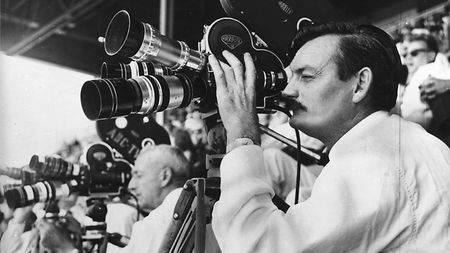1936 – 1965: A Revolution in Design and Technology—The ARRIFLEX 35
ARRI’s big breakthrough in camera design weighed a mere 13.5 lb (6.1 kg) and had a spinning mirror for reflex viewing. It was introduced as a prototype in 1936 and as a production-ready product at the 1937 Leipzig Fair. The ARRIFLEX 35 had a WYSIWYG image: what you saw on the ground glass was identical to the image captured on film, parallax free, and able to show whether the shot was in or out of focus. Erich Kaestner, having joined ARRI at age 21 in 1933, was the chief design engineer of this lightweight, small and rugged camera. From this point on, writers were obliged to distinguish between ARRI the company and ARRIFLEX—the cameras with reflex viewing via spinning mirror shutters.
Cinematographers once again became combat cameramen during World War II. German combat cameramen used ARRIFLEX 35 cameras. The Americans had Bell & Howell Eyemos. The first ARRIFLEX 35s came to America as captured cameras via the US Army Pictorial Center in Queens, New York. Word of the spinning mirror and reflex viewing spread.
ARRI’s factory in Munich was totally destroyed by Allied bombs in 1944, but manufacturing had been moved to the Bavarian countryside several years earlier. The next-generation ARRIFLEX 35 II went into production in 1941; after the war it gained attention in the US for handheld, MOS, documentary and POV shots. A 35 II was used extensively on "Louisiana Story" (1948), directed by Robert Flaherty and shot by Richard Leacock, a pioneer of Direct Cinema and Cinéma Vérité. Tonino Delli Colli AIC shot "The Good, the Bad and the Ugly" (1966), starring Clint Eastwood, with a 35 IICT/B Techniscope 2-perf (2.35:1 aspect ratio) camera. It used half as much film as 4-perf anamorphic, reducing costs and increasing time between reloads. More than 17,000 ARRIFLEX 35 cameras (including its variants: IIA, IIB, IIC) were sold through 1979, when it was replaced by the ARRIFLEX 35 III.
